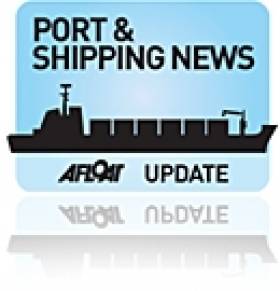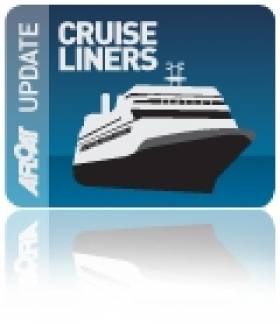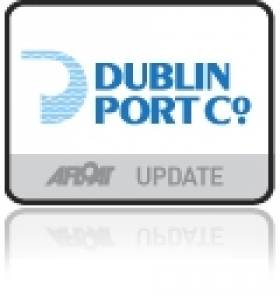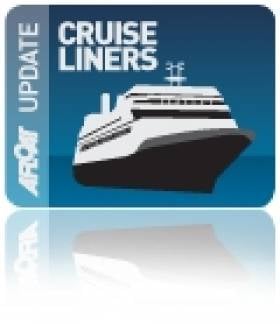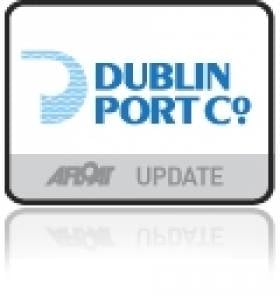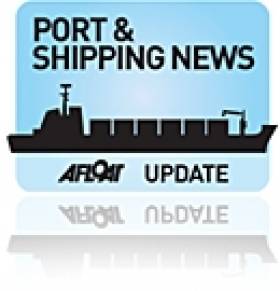Displaying items by tag: Dublin Port
A floating crane-barge with a 1,000 ton lifting capacity hoisted the structure sky-high away from the ship which was berthed at the Grand Bahama Shipyard drydock facility. The ships owners, Princess Cruises cited the main reason for the removal was in order to 'significantly improve the operational performance of the ship, including greater fuel efficiency.'
Grand Princess may have lost her signature Skywalker Nightckub but three-decks below a new nightclub, One5, inspired by its Deck 15 location was created. In addition to this work which took place during April and May the 2,600 passenger cruisehip also underwent a major refit. The ship which had its last major refurbishment in 2004 has amenities to include an outdoor movie screen, fitness centre, spa, casino and four swimming pools.
For 'interactive' deckplans click here and interior slideshow click this link.
The distinctive 'Skywalker' feature became one of the most iconic in cruiseship naval architecture when the Grand Princess was launched as leadship
of the 'Grand' class in 1998. Located at the extreme aft of the vessel, the nightclub could only be reached by clubbers using an angled walkway (photo). Externally the feature was referred by some as the 'shopping trolley' and others percieved the design infleunce from towering poops found on ancient war-faring galleons.
Irrespective of the design origins, another 10 'Grand' class vessels were built by the Italian Fincantieni (at Malfalcone) Shipbuilding Group. The 'handle' (photo) feature on the Grand Princess was made with a heavier material compared to Golden Princess (2001) and Star Princess completed a year later. So there are no plans to remove these nightclubs. Of the more recent additions to the class modifications have appeared, notably without the inclusion of the Skywalker Nightclub's but there are changes to funnel designs.
Outside the Princess Cruises brand, the Ventura and Azura (also of the Grand-class) operate for P&O Cruises, serving the UK market from Southampton. The Hamsphire port welcomed the pioneering leadship Grand Princess on 5 May after she made a 16-day trans-Atlantic repositioning voyage from Port Everglades.
The cruiseship which has a crew of 1,200 alone will make the UK port its seasonal homeport this year from where she sails on cruises in Europe. On one of these cruises itineraries the Grand Princess (290m long x 36 beam X 8.5m draft) included a visit to the Port of Cork today. You can monitor the ship from Cobh Cruise Terminal via the 'live' bridge web-cam, noting the vessel is due to depart at 18.00 this evening bound for Dublin Port.
Grand Princess became the first cruiseship to measure over 100,000 gross registered tonnes when the 108,806 (grt) vessel docked in Dublin on 31 August 2004.
Last year the port handled 88 cruisecalls and this number of vessels is to be closely repeated this season. Over 200 cruise calls with around half a million passengers and crew are scheduled to visit the island of Ireland. The cruise sector business is estimated to generate €60m to the economies
north and south.
Varadkar Warns of No Bail-Out to State-Owned Ports
In the report it was noted that there are too many ports and that the sector would benefit from a rationalisation of ownership and management structures. The decision which will be made over the next few months not only concerns the fate of the capital port but also the following state-owned ports: Dun Laoghaire, Waterford, Drogheda, Dundalk, Cork, Shannon Foynes, Wicklow, New Ross and Galway.
Mr Varadkar also warned that state money wouldn't be made available to bolster ports' balance sheets. "Where port companies are not successful, there will no bailouts and there will be no state aid. "It just isn't possible for the Government in the situation it's in to offer that," he said.
"Where smaller ports find themselves unable to continue operations, amalgamations or transfers to local authorities will be the preferred option."
On the issue of selling Dublin Port the company's chief executive Mr. Eamon O'Reilly who has cited previously that the port should not be sold as a private operator would not have the same incentive to invest as they would be focusing on generating returns.
As for the masterplan, he emphasised that the port would need to double its capacity so to handle the expected trade levels by 2040. He conceded the masterplan will cause some controversy but said the port has "great potential" to facilitate economic growth and make Dublin a better city to live in.
Grasshopper II Makes the Jump on Dublin Bay
The National Yacht Club Trapper 300, Grasshopper II, (Kevin and John Glynn) – one of two Trapper's racing on Dublin Bay this year – made light work of the scratch First 28 Chouskikou (R.Sheehan/R.Hickey) and the Sonata 28 Asterix (Counihan/Meredith/Bushell) to be first home tonight in Dublin Bay Sailing Club's (DBSC) Class Three Tuesday race. The breeze on Dublin Bay was 8-10 knots from the west and this – combined with an ebb tide – produced flat seas, a contrast to the comparatively big waves of the past two weeks.
On the dinghy course in Scotsman's bay Frank Miller's Fireball Blind Squirrel was first home from Marguerite O'Rourke's Samphire. Third was Neil Colin's Elevation, tonight's race being the first since the Leinster championships on Carlingford lough at the weekend. Full results for DUBLIN PORT Dublin Bay Sailing Club Results for 10 MAY 2011 below:
CRUISERS 2 - 1. Cor Baby (Keith Kiernan et al), 2. Free Spirit (John O'Reilly)
CRUISERS 3 - 1. Grasshopper 2 (K & J Glynn), 2. Chouskikou (R.Sheehan/R.Hickey), 3. Asterix (Counihan/Meredith/Bushell)
FIREBALL - 1. Blind Squirrel (Frank Miller), 2. Samphire (Marguerite O'Rourke), 3. Elevation (N.Colin/M.Casey)
GLEN - 1. Glenshane (P Hogan), 2. Glencorel (B.Waldock/K.Malcolm)
IDRA 14 FOOT - 1. Dunmoanin (Frank Hamilton), 2. Doody (J.Fitzgerald/J.Byrne), 3. Squalls (Stephen Harrison)
MERMAID - 1. Kim (D Cassidy), 2. Sallywake (Tony O'Rourke)
PY CLASS - 1. E Ryan (RS400), 2. F.Heath (Laser 1)
RUFFIAN 23 - 1. Alias (D.Meeke/M.McCarthy), 2. Diane ll (Bruce Carswell), 3. Different Drummer (Catherine Hallinan)
Click for the latest Dublin Bay Sailing Club news and results
Mega-Yacht Cruiseship Le Boréal Visits Dublin
At 142m long she was built by the Italian Fincantieri shipyard and can take 264 guests in 132 luxury cabins and in public spaces the interior has a distinctly French flair from the hand of designer Jean-Philippe Nuel. She is flagged in the Wallis Futuna Islands in the Polynesian French island territory in the South Pacific.
The vessel has a cruising speed of 16 knots and a crew of 139 look after her guests throughout six decks. On the top deck named Le Paris Deck an open-air bar is located aft and forward is a sun deck area. Below on Le France Deck there is a swimming pool, grill restaurant, internet station, library panoramic lounge and an adjoining open-decked forward facing terrace sited above the bridge.
On the Le Normandie DecK there is a fitness beauty corner, a massage, hair salon, leisure area and an image & photo desk in partnership with Philippe Plisson, synonymous for his dramatic scenes of Breton lighthouses. The photographer is based in La Trinité sur Mer for more click here.
The next deck is the Le Lafayette Deck which is predominately occupied by 35 Prestige staterooms each featuring private balconies and located aft is the theatre. Going down another deck is the Le Champollian Deck where there is the main lounge, shop, reception desk, excursion desk and a medical center. Finally we reach Le Liberté Deck where guests can dine at the gastronomic restaurant, the Marina.
Twenty three years ago Compagnie du Ponant was founded by her owners the CMA CGM Group, the world's third largest container shipping group. The cruise company is an integral part of French maritime heritage and owes its origins to the renowned Compagnie Générale Transatlantique French Line.
Varadkar to Open Dublin Port Conference
Dr. Leo Varadkar, T.D., Minister for Transport, Tourism and Sport will open a major conference on the future development of Dublin Port at 9 am tomorrow at The Gibson Hotel, Dublin (beside the Point Village). Among the issues to be addressed at the conference will include: economic; infrastructure; planning; transport; tourism; and environmental considerations.
Speakers and panellists on the day will include: Danny McCoy, Director General, IBEC; Jim Power, Economist; Dr. Don Thornhill, Chairman, National Competitiveness Council; Gina Quin, CEO, Dublin Chamber; Michael Stubbs; Dublin City Assistant Manager; John Whelan, CEO, Irish Exporters Association; Eamonn McKeon, CEO, Irish Tourism Industry Confederation; Peter Nash, Tourism Ireland; Nigel O'Neill, Head of Strategic Planning, NRA; Stephen Ahearne, General Manager – Freight, Irish Rail; Tom Wilson of the Freight Transport Association; Marian Wilson; Head of Transport Planning, National Transport Authority; Patrick Verhoeven, Secretary General, European Sea Ports Organisation; Brendan McDonough, Manager of Strategic Planning and EU, IDA Ireland; Eamonn O'Reilly, CEO, Dublin Port Company; and Lucy McCaffrey, Chairperson, Dublin Port Company.
The conference is part of Dublin Port Company's consultation on the future development of Dublin Port, which will need to handle 60 million tonnes - double today's throughput – by 2040. The key question to be addressed is how Dublin Port Company can achieve this taking into consideration the Port's role and responsibilities across trade, tourism, transport and the natural and built environments.
Dublin Port Company is seeking submissions on the development of a Masterplan by 31st May, 2011.
French Mega-Yacht Cruiseship Bound for Dublin Debut
Le Boréal was to make her maiden Irish call to Cobh but the capital which was also scheduled for the 10 May will instead take this honour from the one-year old ship which is operated by France's only cruise operator, Compagnie du Ponant.
The 142m long ship was built by the Italian Fincantieri shipyard won the 'Best New ship of the Year 2010' by the European Cruiser Association. She can take 264 guests in an interior which has a distinctly French flair from the hand of designer Jean-Philippe Nuel. A crew of 139 look after the running of the six-decked vessel which has 132 luxurious appointed cabins.
Late last month Le Boréal was joined by her new sister L'Austral which was inaugurated into service during a fireworks display off the company's headquarters in Marseille. Both ships made a cruise to the Frioul Islands and famous Chateau d'If and later that day their Le Levant also took part in the celebrations when the trio returned off Marseille.
The other two vessels of the five-strong fleet are the Le Ponant, a three-masted 88m sailing ship and Le Diamant (also due Dublin and Cork this season) form a fleet of bijou cruiseships which are small in size and as such can access remote and exclusive ports of call.
Compagnie du Ponant was established in 1988 and is owned by the CMA CGM Group, the world's third largest container shipping group. The company is an integral part of French maritime heritage with origins from the renowned Compagnie Générale Transatlantique French Line.
Dublin Port to Pay €16.5 million Dividend to the State
At today's AGM the Annual Report for 2010 was presented to the Shareholders in advance of publication later this year after it has been laid before the Oireachtas.
Dublin Port Company also outlined its trading outlook for the remainder of the year after a return to growth in throughput in 2010 following two years of decline in trade. These results showed an increase of 6.1% on the previous year to 28.1 million tonnes which is just 9% lower than the historic high of 30.9 million tonnes in 2007.
Addressing Dublin Port Company's AGM, Ms. Lucy McCaffrey, the company's chairperson, said; "I was pleased to report to our shareholders, the representatives of the Minister for Transport and Minster for Finance, that Dublin Port Company will pay a dividend of €6.5 million in respect of the 2010 financial out-turn along with a payment of a special dividend of €10 million. The €16.5m paid this year will bring total distributions to €36.6 million in a five year period. In addition to paying a dividend to our shareholder we remain committed to investing in the port's infrastructure to ensure that Dublin Port remains the efficient modern competitive port it has become. We recently launched a major consultation exercise with all our stakeholders to create a Masterplan for the future development of Dublin Port to ensure that it can continue to serve the trading needs of the city and country for generations to come."
Speaking about the financial performance of Dublin Port Company for 2010, Dr. Leo Varadkar TD, Minister for Transport said; "I congratulate the company on its strong financial performance for 2010 which has enabled it to pay a further dividend to the State. It is encouraging that the company remains a profitable enterprise which continues to pay a dividend to the State, in line with current Government policy in relation to the commercial State companies. Furthermore, it is encouraging that the financial strength of the company will allow it to invest significantly in the future development without recourse to exchequer funding. This country's return to economic prosperity will be export-led and Irish ports will play an important role in facilitating that trade. In this regard the current Masterplan consultation process the company has embarked on is a timely and necessary exercise in preparing for the future."
Moth Dinghy Makes its Dublin Bay Sailing Club Debut
Making its debut for the first time under the club burgee was an International Moth dinghy. The ultra fast hull was airborne at just eight knots of breeze, making even the trapezing Fireballs look slow. But despite the pace the new fangled dinghy did not feature in the overall Portsmouth Yardstick (PY) results. See below.
A healthy turnout of six 'balls, urged on by the fact that the class World Championships is in Sligo in 46 days time, got some trapezing gusts and some planing waves downwind in a north-easterly breeze of 6-8 knots. S. Oram took the winning gun from Louis Smyth sailing Licence to Thrill.
Single handed Lasers boasted twice the Fireball turnout to be the biggest class racing in Scotsman's bay tonight. It's a show of strength from a class surely worthy of its own start if this kind of turnout can be maintained.
Sean Craig won the Laser race from Peter Craig but the overall PY result went to E. Ryan's RS400.
Two Dublin Bay Mermaids and disappointingly, a single IDRA 14, No.124, Squalls also competed.
DUBLIN PORT Dublin Bay Sailing Club Results for 26 APRIL 2011
FIREBALL - 1. nn (S Oram), 2. Licence to Thrill (Louis Smyth), 3. Incubus (C Power/M Barry)
MERMAID - 1. Lively Lady (G O'Neill & M Hanney), 2. Jill (P.Smith/P.Mangan)
PY CLASS - 1. E Ryan (RS400), 2. Sean Craig (Laser), 3. Peter Craig (Laser)
BENETEAU 31.7 - 1. Extreme Reality (P.McSwiney/E.O'Rafferty), 2. Magic (D.O'Sullivan/D.Espey)
BENETEAU 31.7 - 1. Magic (D.O'Sullivan/D.Espey), 2. Extreme Reality (P.McSwiney/E.O'Rafferty)
CRUISERS 2 - 1. Cor Baby (Keith Kiernan et al), 2. Red Rhum (J Nicholson), 3. Free Spirit (John O'Reilly)
CRUISERS 3 - 1. Grasshopper 2 (K & J Glynn), 2. Pamafe (Michael Costello), 3. Papytoo (M.Walsh/F.Guilfoyle)
CRUISERS 4 - 1. Maranda (Myles Kelly), 2. Ghrazel (Charles Pearson), 3. Artemis (J.Giles)
RUFFIAN 23 - 1. Diane ll (Bruce Carswell), 2. Icicle (C & J Murray), 3. Alias (D.Meeke/M.McCarthy)
SIGMA 33 - 1. Rupert (R.Lovegrove/P.Varian), 2. Pippa lV (G.Kinsman/K.Blake/M.O'Brien)
SQUIB - 1. Tais (Michael O'Connell), 2. Periguin (N.Coakley/J.Redahan)
More DBSC News here.
Ulysses Celebrates 10 Years of Irish Sea Service
In January 2000 the keel of the worlds largest car ferry was laid at the Aker Finnyards in Rauma, Finland. The following year the €100m cruiseferry giant departed the shipyard on a four-day delivery voyage to Dublin Port. Upon Ulysses's arrival on 4th March she was presented with a traditional welcoming escort of saluting water-firing tugs.
The Ulysses was named at a ceremony in the port on 21st March by the 'golden godmother' Mairead Berry, Ireland's 25-year old Paralympic Games gold medallist. Four days later Ulysses made her commercial maiden voyage to Holyhead on 25th March.
Wih 12 decks the vessel has an extensive range of facilities and they are named with themes derived from James Joyce's famous novel 'Ulysses'. There is seating available for up to 1,938 passengers and there are 117 twin or single-cabins, accommodating up to 228 passengers.
Only two months into service the Ulysses won the prestigious 'Most Significant New Build - Ferry' category award in the Cruise & Ferry magazine 2001 Awards competition. Her Finnish builders are not only builders of large cruise-ferries for Baltic Sea operators and beyond but also are also renowned for the construction of very large cruiseships for international clients.
Ulysses was designed specifically to serve the central corridor route with a schedule of two round trips daily. She directly replaced the 1997 Dutch built 34,031 grt ro-pax Isle of Inishmore, which transferred to Rosslare-Pembroke Dock service.
In 2006 the Ulysses alongside her fleetmates were transferred from the Irish flag to the Cypriot flag in addition to a change of Irish crew with those outsourced from citizens mostly from the Baltic and Eastern European countries.
Due to the sheer size of the Ulysses, which has a length of 209m, a beam of nearly 32m and a 6.4m draught, she has not missed a single crossing due to bad weather conditions. The vessel has a 22 knot / 41kph service -speed on the 60-mile route which translates to a distance of over 182,000 kms a year.
To celebrate Ulysses 10th year in service, Irish Ferries has enhanced the Club Class option to passengers which includes free-Wifi, which enables a constant connection and an array of other benefits during the 3-hour 15 minute crossing.
For a virtual tour of the Ulysses with views taken from the top deck as the cruiseferry departs Holyhead and the mountains of Snowdonia setting as a backdrop plus interior tours of the vessel click here.
Expansion Is The Only Way Says Dublin Port Chief
Trade at Dublin Port is set to more than double over the next 30 years, according to its chief executive Eamonn O'Reilly.
In an interview with The Irish Times last week, O'Reilly elaborated on the new 'master plan' for the port, which is based on an estimated trade growth to 60 million tonnes (or 2.5% annually) by 2040.
“Last year’s growth [of 6.1%] suggests to me that we need to get our planning caps on and get a solid and robust master plan in place,” said O’Reilly.
The master plan, according to the Dubin Port chief, will require expansion of the existing port by reclaiming up to 40 hectares, as well as a greater integration with bordering areas.
Previous attempts to expand have faced much opposition from conservation groups and local residents for a number of years.
O’Reilly stressed that the local community will be engaged on the issues involved before Dublin Port produces a final proposal at the end of the year.
But he also insisted that "there’s no project [that hee knows of] for port expansion that doesn’t involve reclamation", despite proposals to establish a new port at Bremore.
Read more of the Irish Times interview with Eamonn O'Reilly HERE.



























